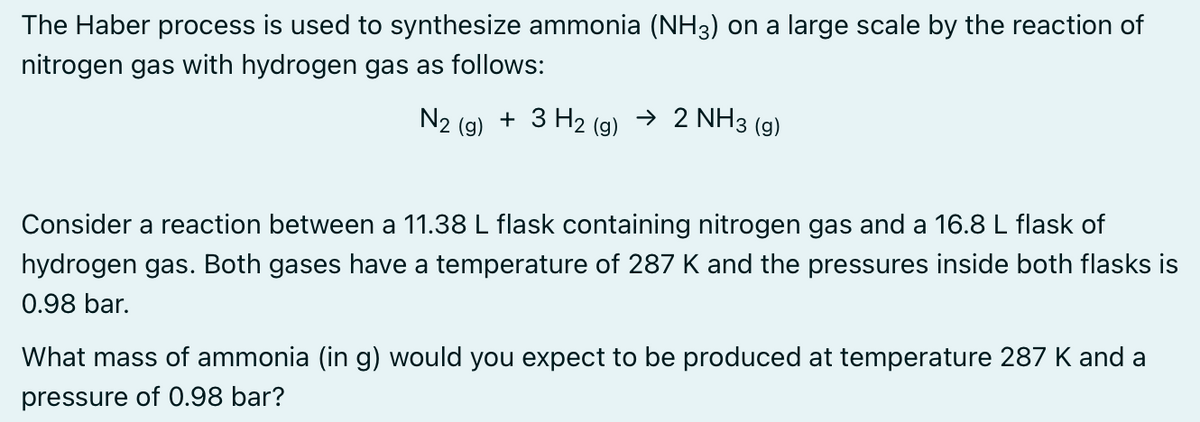The Haber process is used to synthesize ammonia (NH3) on a large scale by the reaction of nitrogen gas with hydrogen gas as follows: N2 (g) + 3 H₂(g) → 2 NH3(g) Consider a reaction between a 11.38 L flask containing nitrogen gas and a 16.8 L flask of hydrogen gas. Both gases have a temperature of 287 K and the pressures inside both flasks 0.98 bar. What mass of ammonia (in g) would you expect to be produced at temperature 287 K and a pressure of 0.98 bar?
The Haber process is used to synthesize ammonia (NH3) on a large scale by the reaction of nitrogen gas with hydrogen gas as follows: N2 (g) + 3 H₂(g) → 2 NH3(g) Consider a reaction between a 11.38 L flask containing nitrogen gas and a 16.8 L flask of hydrogen gas. Both gases have a temperature of 287 K and the pressures inside both flasks 0.98 bar. What mass of ammonia (in g) would you expect to be produced at temperature 287 K and a pressure of 0.98 bar?
Physical Chemistry
2nd Edition
ISBN:9781133958437
Author:Ball, David W. (david Warren), BAER, Tomas
Publisher:Ball, David W. (david Warren), BAER, Tomas
Chapter1: Gases And The Zeroth Law Of Thermodynamics
Section: Chapter Questions
Problem 1.13E: Hydrogen gas is used in weather balloon because it is less expensive than Helium. Assume that 5.57 g...
Related questions
Question

Transcribed Image Text:The Haber process is used to synthesize ammonia (NH3) on a large scale by the reaction of
nitrogen gas with hydrogen gas as follows:
N₂ + 3 H₂ (g)
(g)
→ 2 NH3 (9)
Consider a reaction between a 11.38 L flask containing nitrogen gas and a 16.8 L flask of
hydrogen gas. Both gases have a temperature of 287 K and the pressures inside both flasks is
0.98 bar.
What mass of ammonia (in g) would you expect to be produced at temperature 287 K and a
pressure of 0.98 bar?
Expert Solution
This question has been solved!
Explore an expertly crafted, step-by-step solution for a thorough understanding of key concepts.
This is a popular solution!
Trending now
This is a popular solution!
Step by step
Solved in 3 steps with 3 images

Knowledge Booster
Learn more about
Need a deep-dive on the concept behind this application? Look no further. Learn more about this topic, chemistry and related others by exploring similar questions and additional content below.Recommended textbooks for you

Physical Chemistry
Chemistry
ISBN:
9781133958437
Author:
Ball, David W. (david Warren), BAER, Tomas
Publisher:
Wadsworth Cengage Learning,

Introductory Chemistry: A Foundation
Chemistry
ISBN:
9781285199030
Author:
Steven S. Zumdahl, Donald J. DeCoste
Publisher:
Cengage Learning

Chemistry & Chemical Reactivity
Chemistry
ISBN:
9781337399074
Author:
John C. Kotz, Paul M. Treichel, John Townsend, David Treichel
Publisher:
Cengage Learning

Physical Chemistry
Chemistry
ISBN:
9781133958437
Author:
Ball, David W. (david Warren), BAER, Tomas
Publisher:
Wadsworth Cengage Learning,

Introductory Chemistry: A Foundation
Chemistry
ISBN:
9781285199030
Author:
Steven S. Zumdahl, Donald J. DeCoste
Publisher:
Cengage Learning

Chemistry & Chemical Reactivity
Chemistry
ISBN:
9781337399074
Author:
John C. Kotz, Paul M. Treichel, John Townsend, David Treichel
Publisher:
Cengage Learning

Principles of Modern Chemistry
Chemistry
ISBN:
9781305079113
Author:
David W. Oxtoby, H. Pat Gillis, Laurie J. Butler
Publisher:
Cengage Learning

Chemistry: Principles and Reactions
Chemistry
ISBN:
9781305079373
Author:
William L. Masterton, Cecile N. Hurley
Publisher:
Cengage Learning

Chemistry: Matter and Change
Chemistry
ISBN:
9780078746376
Author:
Dinah Zike, Laurel Dingrando, Nicholas Hainen, Cheryl Wistrom
Publisher:
Glencoe/McGraw-Hill School Pub Co